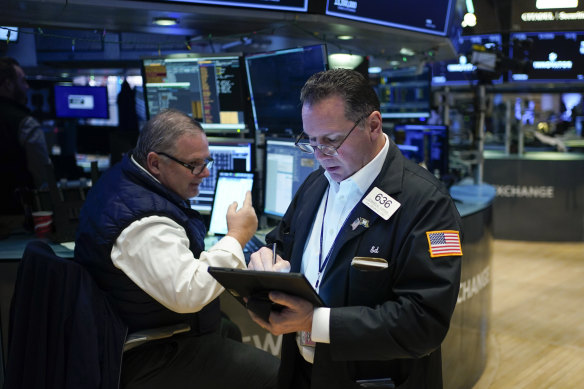ASX set to open higher despite mixed Wall Street session
By Stan Choe
Stocks are mixed on Wall Street after a report showed US shoppers opened their wallets at retail stores last month by much more than expected.
The S&P 500 was 0.3 per cent lower in early afternoon trading after paring a larger early loss. The Dow Jones was down 0.3 per cent and the Nasdaq composite was 0.2 per cent higher. The Australian sharemarket is set to rise with futures at 5.02am AEDT pointing to a jump of 18 points, or 0.3 per cent, at the open. The ASX dropped by 1.1 per cent on Wednesday.

Sales at US retailers jumped more than expected, even as shoppers contend with higher interest rates on credit cards and other loans. The surprising strength offers hope that the most important part of the US economy, consumer spending, can stay afloat despite worries about a possible recession looming. It’s the latest piece of data to show the economy remains more resilient than feared.
At the same time, though, the strong buying potentially adds more fuel to inflation, which a report earlier this week showed is cooling by less than expected. Upward pressure on inflation could force the Federal Reserve to stay more aggressive in keeping interest rates high.
High rates can drive down inflation, but they also drag on investment prices and raise the risk of a painful recession.
“Will it lead to that traditional recession or a shallow recession, or will we power through it and have more strong growth with still-high rates?” said Tom Hainlin, national investment strategist at US Bank Wealth Management. “That’s still the unknown, which is how resilient can the consumer be in this higher for longer” rate environment.
“It seems like both consumers and corporate America came into this in pretty good shape and so far are holding out OK,” he said.
The worries about higher rates and a firmer Fed have been most evident in the bond market, where yields on Treasurys have jumped since a report two Fridays ago showed the US job market remains stronger than expected.
The yield on the two-year Treasury, which tends to track expectations for the Fed, briefly jumped toward 4.70 per cent after the retail sales report, up from less than 4.60 per cent overnight and from 4.62 per cent late Tuesday. It then eased back to 4.66 per cent, still near its highest level since November.
The 10-year yield, which helps set rates for mortgages and other important loans, rose to 3.79 per cent from 3.75 per cent late Tuesday.
Following Tuesday’s data on inflation that was slightly hotter than expected, economists at Deutsche Bank raised their forecast for how high the Fed will take its key overnight interest rate. They now see it ultimately rising to 5.6 per cent, up from their prior forecast of 5.1 per cent.
The Fed has already pulled its overnight rate all the way to a range of 4.50 per cent to 4.75 per cent, up from virtually zero a year ago.
The Deutsche Bank economists said they still expect a recession, but that the near-term strength in the economy could push its timing into the last three months of the year, later than they earlier thought.
Many other traders have also been raising their forecasts for how high the Fed will ultimately take interest rates. They’ve also sharply reduced bets for the Fed to cut rates late this year.
Even still, stocks are hanging onto healthy gains for the year despite recent rockiness. The S&P 500 is up 7.4 per cent as strong data reports build hope that the economy may be able to avoid a recession. Or, if one hits, perhaps it may be only a short and shallow one.
The next big milestone for the market will likely be the Fed’s meeting in late March, where policymakers will give their latest forecasts for where interest rates will be at the end of the year, Hainlin said. That could lead to choppy trading in markets until then, as investors try to guess which way it will go.
On Wall Street, shares of Airbnb jumped 12.8 per cent Wednesday after reporting stronger profit and revenue for its latest quarter than analysts expected. It also said trends remain encouraging into the new year, and it gave a forecast for revenue that topped Wall Street’s.
On the losing end were stocks of energy producers, which dropped with the price of oil. Energy stocks in the S&P 500 fell 2.3 per cent, by far the worst performance of the 11 sectors that make up the index.
One of the sharpest drops in the S&P 500 came from Devon Energy, which fell 11.1 per cent after reporting weaker profit for the latest quarter than expected.
This earnings reporting season has been muted, with many companies reporting pressure on their profits from high costs and interest rates.
In stock markets abroad, Turkey’s market jumped nearly 10 per cent after trading reopened following a closure caused by the devastating earthquake in the region.
European stocks were modestly higher, with Germany’s DAX returning 0.8 per cent. Asian stocks were weaker, with Hong Kong’s Hang Seng down 1.4 per cent and South Korea’s Kospi down 1.5 per cent.
Most Viewed in Business
Source: Thanks smh.com